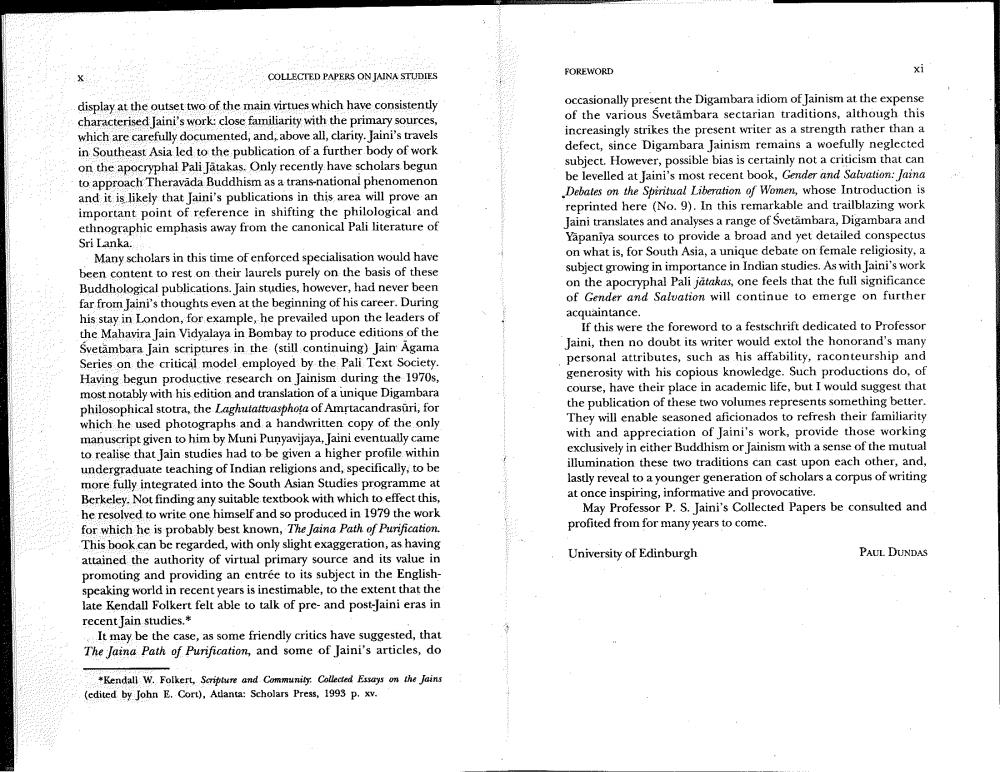________________
COLLECTED PAPERS ON JAINA STUDIES
display at the outset two of the main virtues which have consistently characterised Jaini's work: close familiarity with the primary sources, which are carefully documented, and, above all, clarity. Jaini's travels in Southeast Asia led to the publication of a further body of work on the apocryphal Pali Jätakas. Only recently have scholars begun to approach Theravada Buddhism as a trans-national phenomenon and it is likely that Jaini's publications in this area will prove an important point of reference in shifting the philological and ethnographic emphasis away from the canonical Pali literature of Sri Lanka.
Many scholars in this time of enforced specialisation would have been content to rest on their laurels purely on the basis of these Buddhological publications. Jain studies, however, had never been far from Jaini's thoughts even at the beginning of his career. During his stay in London, for example, he prevailed upon the leaders of the Mahavira Jain Vidyalaya in Bombay to produce editions of the Śvetämbara Jain scriptures in the (still continuing) Jain Agama Series on the critical model employed by the Pali Text Society. Having begun productive research on Jainism during the 1970s, most notably with his edition and translation of a unique Digambara philosophical stotra, the Laghutattvasphota of Amṛtacandrasuri, for which he used photographs and a handwritten copy of the only manuscript given to him by Muni Punyavijaya, Jaini eventually came to realise that Jain studies had to be given a higher profile within undergraduate teaching of Indian religions and, specifically, to be more fully integrated into the South Asian Studies programme at Berkeley. Not finding any suitable textbook with which to effect this, he resolved to write one himself and so produced in 1979 the work for which he is probably best known, The Jaina Path of Purification. This book can be regarded, with only slight exaggeration, as having attained the authority of virtual primary source and its value in promoting and providing an entrée to its subject in the Englishspeaking world in recent years is inestimable, to the extent that the late Kendall Folkert felt able to talk of pre- and post-Jaini eras in recent Jain studies.*
It may be the case, as some friendly critics have suggested, that The Jaina Path of Purification, and some of Jaini's articles, do
*Kendall W. Folkert, Scripture and Community Collected Essays on the Jains (edited by John E. Cort), Atlanta: Scholars Press, 1993 p. xv.
FOREWORD
xi
occasionally present the Digambara idiom of Jainism at the expense of the various Śvetämbara sectarian traditions, although this increasingly strikes the present writer as a strength rather than a defect, since Digambara Jainism remains a woefully neglected subject. However, possible bias is certainly not a criticism that can be levelled at Jaini's most recent book, Gender and Salvation: Jaina Debates on the Spiritual Liberation of Women, whose Introduction is reprinted here (No. 9). In this remarkable and trailblazing work Jaini translates and analyses a range of Svetämbara, Digambara and Yapaniya sources to provide a broad and yet detailed conspectus on what is, for South Asia, a unique debate on female religiosity, a subject growing in importance in Indian studies. As with Jaini's work on the apocryphal Pali jätakas, one feels that the full significance of Gender and Salvation will continue to emerge on further acquaintance.
If this were the foreword to a festschrift dedicated to Professor Jaini, then no doubt its writer would extol the honorand's many personal attributes, such as his affability, raconteurship and generosity with his copious knowledge. Such productions do, of course, have their place in academic life, but I would suggest that the publication of these two volumes represents something better. They will enable seasoned aficionados to refresh their familiarity with and appreciation of Jaini's work, provide those working exclusively in either Buddhism or Jainism with a sense of the mutual illumination these two traditions can cast upon each other, and, lastly reveal to a younger generation of scholars a corpus of writing at once inspiring, informative and provocative.
May Professor P. S. Jaini's Collected Papers be consulted and profited from for many years to come.
University of Edinburgh
PAUL DUNDAS




